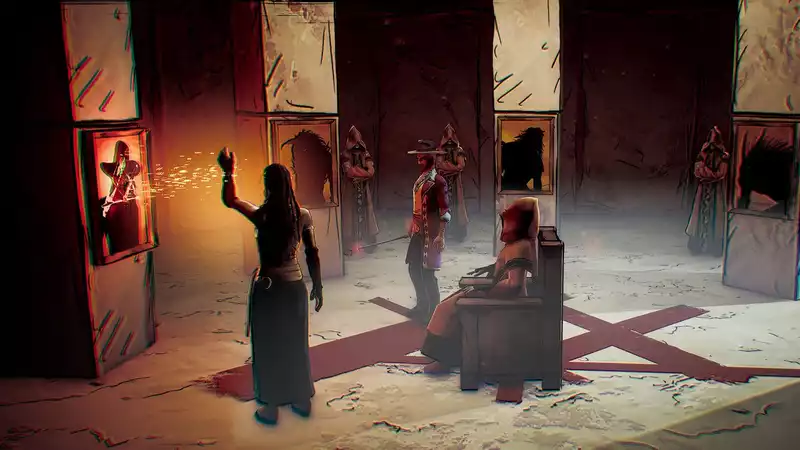I have lived many lives while traveling the strange west. Bounty hunter, werewolf, pig man ...... It has been unforgettable. And in every life I have made the West a little better or a little worse. Like other immersive sims such as "Dishonored" and "Prey," "Weird West" emphasizes the big picture, just as games always require micro-decisions: stealth or direct assault, Molotov cocktails and oil barrels or revolvers and John Woo's slow motion dive. It emphasizes the big picture.
That big picture begins in a familiar place: a retired bounty hunter trying to locate her kidnapped husband. For the first few hours, he tussles with the outlaws in typical frontier Western fashion and wonders where the weirdness is. We traversed the open-world map, which was crammed with abandoned mines, ghost towns, and isolated homes, buying supplies in towns and accepting bounties before setting out. Often these places are teeming with enemies, who can be crept past or filled with lead in fast-paced, top-down combat.
Perhaps it's because I learned that Weird West's creative director, Rafael Colantonio, was the co-director of the original "Dishonored" and the director of "Prey," but at least at first I thought Weird West and I couldn't help but compare Arkane's immersive sim. While they are similar, especially in the variety of approaches available once you enter a hostile environment, the action is not as clever or inventive as in Arkane's game. Unlockable abilities mainly increase damage output, add elemental effects, or hit multiple targets, and abilities cannot be synergized in a meaningful way like the outsider power in Dishonored 2. I'm fighting against a son of a bitch who is clearly going to kill me, whether it's a gang member, a monstrous siren, or a gold-mad colonist.
I would zoom in to get a better grasp of the characters and environment, zoom out to get a bird's eye view of the level, and in the process, find myself being discovered. When the combat begins, it is refreshingly and mercifully quick. However, the dim visual style and overly complicated twin-stick controls made it less enjoyable.
My main takeaway from the top-down sneaking and shooting is that Mimimi Games, the developer of Desperados III, is much better at it. Thankfully, "Weird West" has more to offer than just combat.
We mentioned the pig man earlier, and now it's Chekov's turn to have his gun go off. In the second story of this anthology, a man who looks like a combination of an impure man and a pig leaves the swamp to seek revenge on the witch who did this to him. As he travels around the world in search of clues to his true identity, a deluge of strange things appear. He chats with a foul-mouthed tree of perception and battles witches in an ancient underground temple.
Structurally, all five stories are similar and unfold as miniature CRPGs with main and side quests and companions who can accompany you on your adventures. The protagonists of the previous chapters can also be made companions, each of them branded with a mystical marker. Each new chapter adds to the western weirdness, immersing you ankle-deep in an overarching story about an ancient entity and its body-hopping passenger. It's a fascinating story with memorable characters, including Pigman Joe, who is cursed to communicate only in rhyme. I couldn't wait to see how it would unfold and was quite satisfied with the ending.
Each new chapter is a kind of fresh start, but certain elements are carried over. Passive character perks persist throughout the game, and the former protagonist retains his inventory, reducing the need to gather supplies in later chapters. The main thing that persists, however, is the western state, which is shaped by your decisions, large and small.
To give an example, and this will spoil the second chapter, you can choose to leave your fellow pigmen as soulless shells or to return their lost souls to their bodies; if you choose the second option, they go out into society and appear in subsequent chapters as NPCs; if you choose the third option, they go out into the world and appear in subsequent chapters as NPCs. Not every decision is noteworthy, and some are merely footnotes in the daily news, but it is possible to feel that you are making an impact on the world.
You can also wipe out the inhabitants of a settlement and turn it into a ghost town. This is not part of the story, but something you could do if you wanted to. If you kill everyone in the town of Grackle, from the shopkeepers to the sheriff, the place will be in ruins. The next time you visit, it may be inhabited by bandits. Likewise, if you wipe out a town occupied by bandits, its former inhabitants may eventually return home.
In reality, one town is so little different from another that it is unlikely to be missed in ruins, but the possibilities are exciting. On one occasion, a story ally ambushed me and attacked me in a scripted event on the way to my destination. I died several times trying to win the battle that followed, but I reloaded my previous save and killed the ally before she could turn the blade on me. The ambush still happened, but my attacker was one woman short.
There will be better examples when "Weird West" comes out; the ending of "Weird West" takes everything into account, so be careful who you kill and every decision you make. Far more than most games with branching stories or moral systems, Weird West looks at everything you do.
.

Comments